This was published 5 months ago
The gracious, spacious suburb people move to – and never leave
By Carolyn Webb

Locals say Ivanhoe has plenty of open space and character.Credit: Michael Rayner
It happens on a regular basis: Chris and Roslyn Carolane will get a phone call from an inquiring real estate agent, on the off chance they are looking to sell their stately 106-year-old Ivanhoe house.
“We have agents ring us saying, ‘Would you like an assessment on your house?’” says Chris. “We say, ‘We’re not moving’.”
Chris, 71, who has lived on Ivanhoe Parade all his life, mostly in this house that his grandfather bought in 1923, understands these pitches.
He can see the appeal to buyers of the elegant, plane tree-lined street, which is quiet but a short walk to Ivanhoe’s busy shopping strip and the station, in this suburb 11 kilometres north-east of Melbourne CBD.

Roslyn and Chris Carolane have lived in this Ivanhoe house since 1976. It’s not for sale.Credit: Eddie Jim
Chris and Roslyn bought their World War I-era Edwardian bungalow, with its lovely garden, from Chris’s mother in 1976 for $27,000 – a price based on a local real estate agent’s quote. About 18 months ago, it was valued at $2.5 million.
Like many houses in the street, it’s been extended, with a new living area, bedroom, bathroom and laundry added in 1996.
But if there’s one refrain you hear in Ivanhoe, it’s that people who move there tend to stay.
“My wife and I were talking about downsizing, but we thought, ‘Where else would we go that’s better than this?’” said Chris, an associate priest at St Paul’s Cathedral in the city who also preaches at inner northern suburban Anglican churches.
Roslyn says Ivanhoe has a good sense of community, is close to hospitals – the Austin, the Mercy and Warringal Private – and has lovely parks beside Darebin Creek and the Yarra River.
“We’re close to the shops, Ivanhoe station, to several bus routes, and the swimming pool and gym is nearby in Waterdale Road,” Chris said.
“It’s a really lovely place to live.”
People stay
That’s not to say it’s perfect. Ivanhoe Grammar and Ivanhoe Girls’ Grammar are two long-established private schools but the nearest state secondary school is Thornbury High, four kilometres away.
In the 1960s, Chris went to Heidelberg High, but that closed – as the renamed Banksia Secondary College – in 2011.
And younger relatives with children would like to live in Ivanhoe, but now live in nearby Bellfield because they can’t afford property in the suburb.
Stewart Oldmeadow, a director of Miles Real Estate, says Ivanhoe is “a very long-held suburb”, desirable for aspects such as its many parks, nearby hospitals and sports clubs.
The entry-level price for a house in Ivanhoe is about $1.5 million. The record house sale for the suburb, for a mammoth place in Riverside Road overlooking the Yarra, was $13.5 million in 2022.
According to a suburb property report compiled in June 2024 by data website Pricefinder, which is owned by Domain, the median house sale price in Ivanhoe rose from $590,000 in 2006 to $1.75 million in 2023 – even touching $1.9 million in 2022.
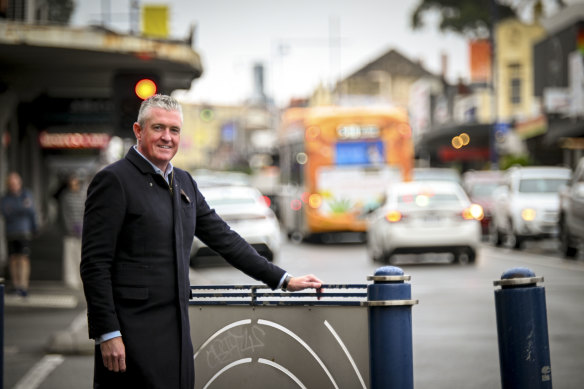
Real estate agent Stewart Oldmeadow says Ivanhoe is “a very long-held suburb”.Credit: Eddie Jim
Oldmeadow says the cheapest two-bedroom flat in Ivanhoe typically sells for between $500,000 and $700,000.
And the rental situation is tight. “We manage over 2500 properties and our vacancy rate at the moment is 0.6 per cent,” he said.
The tension between the need for more housing and the rise in developments that some residents fear threatens Ivanhoe’s gracious, spacious, century-old neighbourhood character is a hot topic in this mostly middle-class suburb.
Since colonial times, Ivanhoe – named after the Sir Walter Scott novel – has been mostly affluent, although not to the level of a Toorak or Brighton.
Steve Barlow, from the Heidelberg Historical Society, said that in the early 20th century, part of Ivanhoe was known as “Hide Park”. Leather and shoe industry bosses built big houses there, while their factories were in suburbs such as Collingwood and Fitzroy.
But it was the railway service becoming reliable and direct in 1901 – then electrified in 1921 – that kick-started suburban housing.
There was a growth spurt of red brick Edwardian houses in the early 1900s and estates sprang up in the 1920s and ’30s. After World War II, areas of two and three-storey flats emerged.
Today, at the Ivanhoe shops on Upper Heidelberg Road, there are Coles and Woolworths supermarkets, but most stores are small and family-run.
“It’s perhaps not the grand shopping centre that, say, Burke Road, Camberwell is, or even Puckle Street, Moonee Ponds is,” Barlow said.
Ivanhoe Traders Association president Zack Silvestro, who owns Coffee Plus Cafe in an arcade at the corner of Upper Heidelberg and Waterdale roads, said businesses were feeling the pinch of higher inflation and wages.
Due to higher costs of living affecting retail spending, traders have had to work harder to attract customers.
Silvestro, who grew up locally in the 1990s and early 2000s, said there were fewer clothes shops, fruit shops or butchers – and no milk bars – now, but more beauty and pilates outlets, medical clinics, restaurants and a new bookshop.
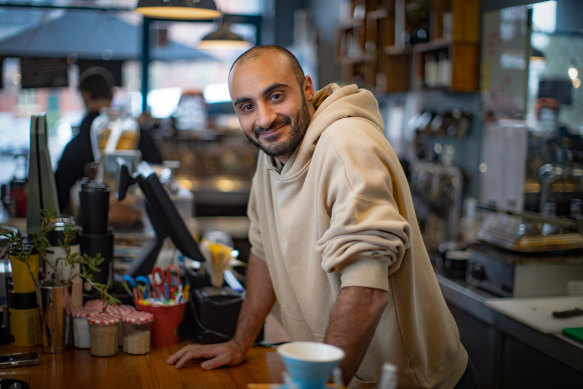
Coffee Plus Cafe owner Zack Silvestro says the number of coffee shops in the suburb has surged.Credit: Simon Schluter
The number of cafes has doubled to about 16, which Silvestro doesn’t think is excessive.
“I think they all cater for a different kind of clientele,” Silvestro said.
“I’ve always had a real coffee focus ... on the different types of beans. Others veer towards cakes or specific types of cuisine.
“There’s a gluten-free cafe up the road, so there is a wide range of options.”
His customer Paige Palmieri, 27, has lived in Ivanhoe for a year. She moved from Preston and is renting.
Palmieri, who refurbishes prams, comes to the Ivanhoe shops frequently for coffee.
It’s a good community, she says, citing a flyer in the Coffee Plus window recently asking for people to cook meals for a family in need. She says it’s a safe area.
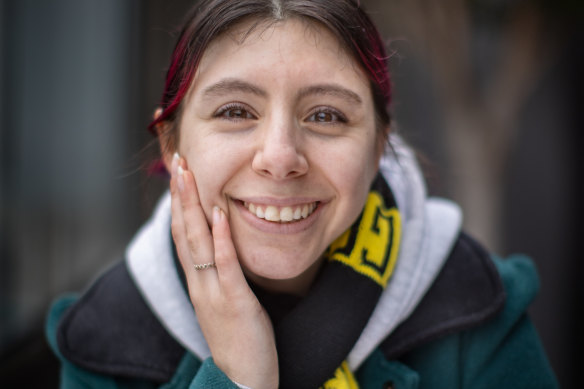
Paige Palmieri says Ivanhoe is a good community and a safe area.Credit: Simon Schluter
However, Palmieri would probably not shop for clothes in Ivanhoe. “I think that they’re over-priced and not really my style,” she said.
Sue Bellini, 74, considers herself the quintessential Ivanhoe person.
She grew up in a modern, one-storey house built in the late 1950s – with plenty of glass, wood panels, and metal stilts painted orange – designed by her architect father Douglas Alexandra. It was on The Boulevard, overlooking the Yarra River.
Bellini went to Melbourne Girls Grammar. Later, while studying Arts at La Trobe University, she protested against the Vietnam War, which she said influenced her to be a Labor voter. She went on to teach English to refugees.
As a single mother in the early 1980s, Bellini bought a house in nearby Alphington for $29,000 and sold it 30 years later for about $700,000.
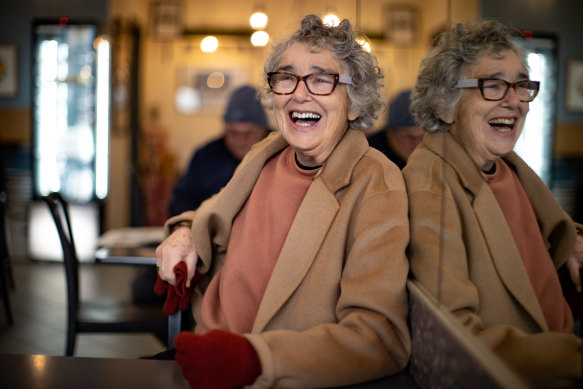
Sue Bellini grew up in Ivanhoe in a house on The Boulevard, overlooking the Yarra River.Credit: Simon Schluter
Bellini returned to Ivanhoe and now lives in a 1960s apartment she bought on Locksley Road. She likes being able to walk to the shops.
Her childhood home on The Boulevard, which passersby used to stop to admire before her family sold it long ago, was recently demolished for “something more expensive and bigger – a big house”.
Building up
Today, the main shopping street in Upper Heidelberg Road is mostly single and double-storey shops but, in the past decade, a cluster of five-storey apartment buildings with shops at ground level has sprung up at its southern end.
In Westley Avenue, just off the strip, is the eight-level Evergreen apartment block.
Heading south towards the city from Ivanhoe shops, a stretch between Heidelberg Road and Darebin railway station is lined with new, five-storey blocks of flats.
More will come. Michael Buxton, an emeritus professor of environment and planning at RMIT University, predicts that within the next 20 years, the Upper Heidelberg Road shopping strip will be dominated by medium and high-rise apartment blocks.
Under the state government’s draft housing targets announced last month, 47,000 new homes would be built in the city of Banyule – which includes Ivanhoe – by 2051, an increase of 87 per cent.
Buxton said the plan would have “far-reaching implications for Ivanhoe” with the shops and the railway station nearby in Norman Street deemed activity centres that suit such developments.
He said the new high-rise blocks would “completely change their character into very alienating places”.
“But it all depends on how much councils and residents fight back,” Buxton said.
“If they accept this, it will happen. If they don’t accept it, then they may be able to influence government to stop this.
“Otherwise you won’t recognise places like that shopping centre in a very short period of time.”
Anthony Carbines, the state member for Ivanhoe and a minister in the Allan government, said developers had applied to build apartment blocks up to 15 storeys high in Ivanhoe.
But he said locals treasured the suburb’s character – and were willing to defend it.
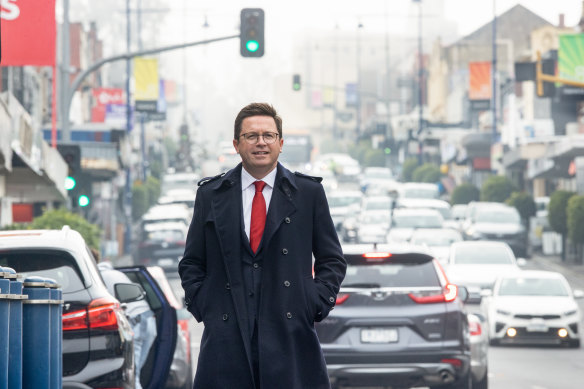
Local MP Anthony Carbines says Ivanhoe residents are willing to defend the suburb and fight to maintain its character.Credit: Simon Schluter
Carbines said developers could find themselves up against objecting residents who had day jobs as lawyers, planning consultants or academics.
“It all ramps up pretty quickly,” said Carbines, a former City of Banyule councillor.
“All of a sudden you end up with some pretty strong wherewithal, from a community that’s got a lot of breadth and depth to it around its capacity to advocate and represent itself and the expectations it then has of its local MP and council and the like.”
One proposal that has faced local objections is on the site of a former church and tennis courts at 321 Lower Heidelberg Road, north of Ivanhoe East shops, which was initially slated for an aged care facility, child care centre, medical centre, cafe, gym and pool across five levels. A revised proposal is for a childcare centre, medical centre, cafe, health club and gallery-events space.
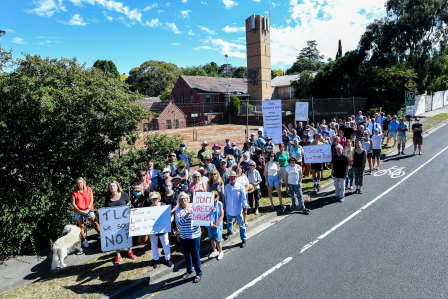
Ivanhoe residents protest in opposition to a development at 321 Lower Heidelberg Road, Ivanhoe East in 2022.Credit: Joe Armao
Developer TLC spent more than $14 million buying the 6293-square-metre site, which spans seven residential titles along Lower Heidelberg Road and King Street.
The council has received more than 100 objections over the scale of the building, traffic congestion and its impact on residential amenity.
In addition, a covenant on the land restricts development to not more than one dwelling house, among other requirements.
Elise Burchsmith, the president of the Save Ivanhoe East Association and whose background is in law, said the group formed in 2019 in response to that development.
She said it also opposes the current proposal, saying the developer should build single-dwelling homes on the site as per the covenants.
TLC was approached for comment.
Burchsmith knows of about seven residents groups in the Ivanhoe area that are passionate about preserving neighbourhood character and environment, and willing to challenge inappropriate development.
Residents are keen to protect the area’s community feel, with its community groups, schools, sporting fields, walks by the Yarra and leafiness, said Burchsmith, who moved to Ivanhoe East 11 years ago with her family.
Development of land around Ivanhoe railway station looks set to be another local focus of attention.
The five-level Hallmark project, with more 30 large-scale luxury apartments in Norman Street Ivanhoe opposite the station, has already been built.
When asked if there would be apartment blocks right beside Ivanhoe station, as there has been at Rosanna, Darebin and Fairfield stations, City of Banyule Mayor Tom Melican said there could be – at a maximum eight storeys high.
“The state government is targeting around railway stations [for housing] and I think that’s the right thing to do,” Melican said.
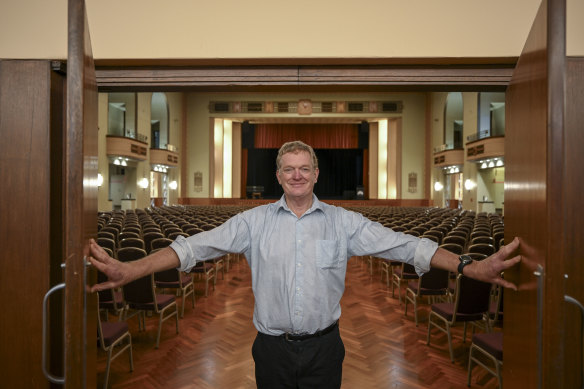
City of Banyule Mayor Tom Melican supports the state government’s plan for more housing around traion stations – up to a point.Credit: Eddie Jim
However, Melican said the council obtained mandatory height limits for Ivanhoe “activity centres” – such as shops and stations – of four, six and eight storeys, which few suburbs had achieved.
“In most activity centres they have recommended heights, but we have mandatory heights so you can’t go over that.”
The mansion
There is one glaring Ivanhoe issue that both Melican and Carbines concede is out of government hands: the fate of the Ivanhoe RSL site.
The heritage-listed mansion in Studley Road – at the north end of Ivanhoe shops – was the RSL’s home for generations, but was gutted by fire in 2017 and remains a fenced-off ruin.
Carbines told this masthead he wanted it to be turned into a public park, named Fred Cullen Reserve after the late World War II veteran who was an Ivanhoe RSL committee member or president for more than 60 years.
Carbines said the Ivanhoe RSL committee and the trust that owned the land, had demonstrated “a distinct failure to progress anything at all”.
“So nobody’s winning from that, and it’s a very shameful legacy for Fred and the community.”
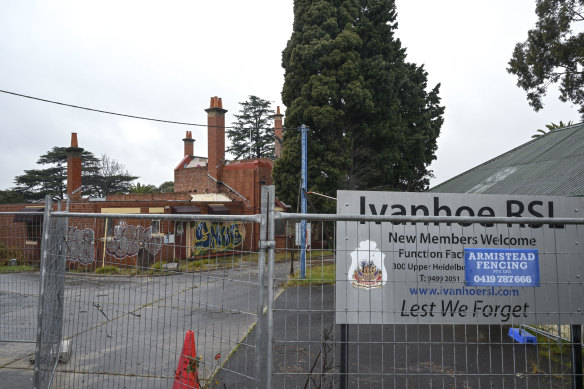
The Ivanhoe RSL was gutted by fire in 2017 and remains fenced-off.Credit: Eddie Jim
This masthead reported in 2022 that any rebuilding of the club has been hopelessly hamstrung by members’ in-fighting and bureaucracy.
A source with knowledge of the trust, speaking anonymously because they were not permitted to speak to the media, described the situation as “a bloody shambles”.
They called on RSL headquarters to step in and “get the bloody thing moving”.
But the source did not believe that creating a park would be feasible, as the terms of the property’s deed state that the site’s function was to provide a place for veterans and their families to congregate.
The source said the rule could be changed but nothing could be done until the insurance claim was finalised.
Melican said the Ivanhoe RSL situation was “very sad”.
“But something needs to happen there,” he said, adding that there was already a park across the road, at the corner of Upper Heidelberg and Studley roads.
The trust that owns the site would not comment. But Ivanhoe RSL president Dino De Marchi said the planning issues surrounding the project had proven to be a bureaucratic challenge.
“The RSL committee remains optimistic about the cooperation we received from past trustees in navigating through these hurdles,” De Marchi said.
A spokesperson for the RSL head office said their powers to intervene were limited as the property in question was not under RSL Victoria Trusteeship.
“The rebuilding of the property is a matter for the trustees of the property, and questions regarding this matter should be directed to them.”
Get the day’s breaking news, entertainment ideas and a long read to enjoy. Sign up to receive our Evening Edition newsletter here.